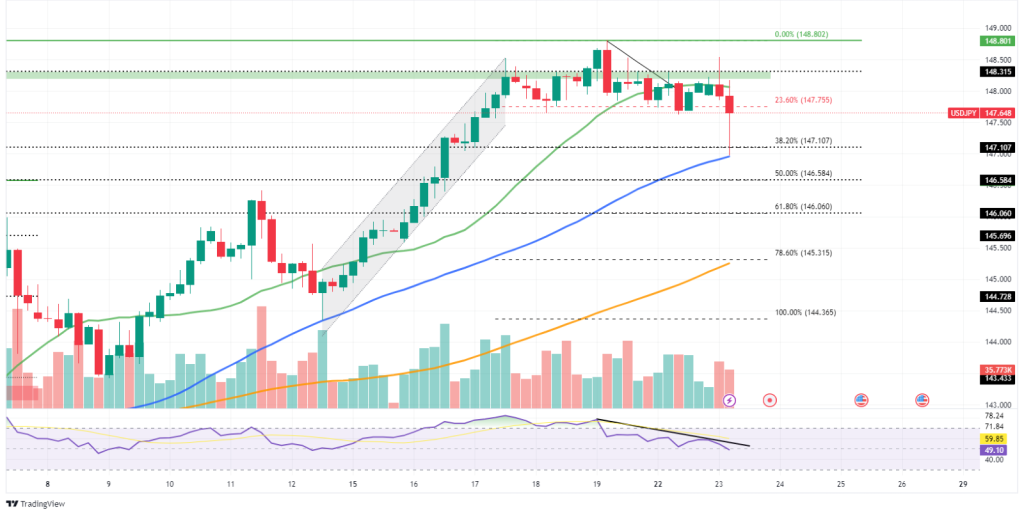
The USD/JPY pair experienced a 0.33% decline following the Bank of Japan’s (BoJ) decision to maintain its ultra-loose monetary policy. The BoJ’s widely expected move retained the key short-term interest rate at -0.1%, with the 10-year bond yield targeted around 0%. The BOJ reiterated its commitment to negative interest rates and the 1% upper limit on 10-year JGB yields, effectively ensuring continued monetary easing in the foreseeable future. This stance aligns with Japan’s sluggish inflation, which dipped to a 17-month low in December 2023.
Governor Ueda’s comments suggesting a gradual rise in the likelihood of achieving the 2% inflation target and his acknowledgement of the increasing need for policy normalization cast a shadow of doubt on the longevity of the ultra-loose policy. This signals a potential shift towards tighter monetary policy in the future, albeit not in the immediate term. Investor sentiment remains mixed. The continuation of easing is perceived as negative for the yen, potentially pushing the USDJPY higher. However, Ueda’s hawkish undertones introduce uncertainty, causing some investors to hold back on aggressive bets.
Technical
The 4-hour chart shows that the USDJPY pair is currently trading at 1.47.648, with the price action trading below the 23.60% Fibonacci retracement level after the bears’ attempt to push the price lower found significant support at the 38.20% Fibonacci retracement level lower.
The 20-SMA (green line) trades comfortably above the upward-sloping 50-SMA (blue line) and 100-SMA (orange line), suggesting underlying bullish momentum. However, the recent dip indicates a potential test of these levels. The falling RSI (49.10) below the 50 level shows the presence of bearish pressure. A break below the RSI-based MA could further confirm the downward trend.
Short-term trading opportunities could exist towards the resistance level at the 148.315 price level should the push below the 23.60% Fibonacci retracement level falter. A break above the initial resistance could confirm the bullish momentum, likely bringing the 148.801 resistance level into play.
Conversely, a successful push below the 23.60% Fibonacci retracement level could offer short-term trading opportunities towards the initial support at the 38.20% Fibonacci retracement level (147.107). A break below the 147.107 level would likely bring the 50.00% Fibonacci retracement level (146.584) and 61.80% Fibonacci retracement level (146.060) support level into play in the short term.

Summary
The short-term outlook for USDJPY is a tug-of-war between bullish momentum and bearish pressures. While the BoJ’s dovish stance currently underpins the yen, Governor Ueda’s comments introduce a potential shift in the wind. A sustained push above the 23.60% Fib and initial resistance at 148.315 could trigger further bullish momentum towards 148.801. A failure to hold above the 23.60% Fib and 148.315 could signal a bearish reversal, potentially targeting the 38.20% Fib and initial support at 147.107.
Sources: TradingView, Trading Economics, Bank of Japan.
Piece written by Mfanafuthi Mhlongo, Trive Financial Market Analyst
Disclaimer: Trive South Africa (Pty) Ltd (hereinafter referred to as “Trive SA”), with registration number 2005/011130/07, is an authorised Financial Services Provider in terms of the Financial Advisory and Intermediary Services Act, 37 of 2002. Trive SA is authorised and regulated by the South African Financial Sector Conduct Authority (FSCA) and holds FSP number 27231. Trive Financial Services Ltd (hereinafter referred to as “Trive MU”) holds an Investment Dealer (Full-Service Dealer, excluding Underwriting) Licence with licence number GB21026295 pursuant to section 29 of the Securities Act 2005, Rule 4 of the Securities Rules 2007, and the Financial Services Rules 2008. Trive MU is authorized and regulated by the Mauritius Financial Services Commission (FSC) and holds Global Business Licence number GB21026295 under Section 72(6) of the Financial Services Act. Trive SA and Trive MU are collectively known and referred to as “Trive Africa”.
Market and economic conditions are subject to sudden change which may have a material impact on the outcome of financial instruments and may not be suitable for all investors. Trive Africa and its employees assume no liability for any loss or damage (direct, indirect, consequential, or inconsequential) that may be suffered. Please consider the risks involved before you trade or invest. All trades on the Trive Africa platform are subject to the legal terms and conditions to which you agree to be bound. Brand Logos are owned by the respective companies and not by Trive Africa. The use of a company’s brand logo does not represent an endorsement of Trive Africa by the company, nor an endorsement of the company by Trive Africa, nor does it necessarily imply any contractual relationship. Images are for illustrative purposes only and past performance is not necessarily an indication of future performance. No services are offered to stateless persons, persons under the age of 18 years, persons and/or residents of sanctioned countries or any other jurisdiction where the distribution of leveraged instruments is prohibited, and citizens of any state or country where it may be against the law of that country to trade with a South African and/or Mauritius based company and/or where the services are not made available by Trive Africa to hold an account with us. In any case, above all, it is your responsibility to avoid contravening any legislation in the country from where you are at the time.
CFDs and other margin products are complex instruments and come with a high risk of losing money rapidly due to leverage. You should consider whether you understand how these products work and whether you can afford to take the high risk of losing your money. Professional clients can lose more than they deposit. See our full Risk Disclosure and Terms of Business for further details. Some or all of the services and products are not offered to citizens or residents of certain jurisdictions where international sanctions or local regulatory requirements restrict or prohibit them.




